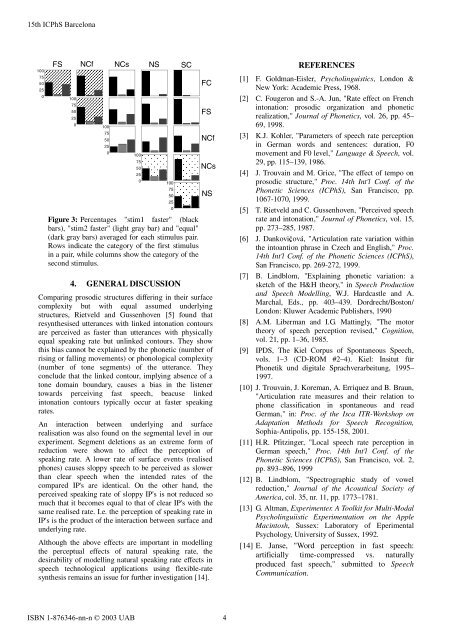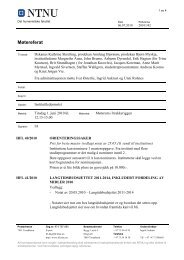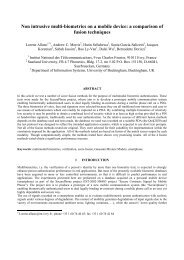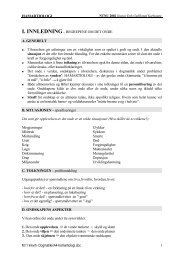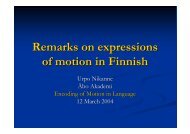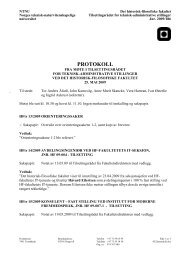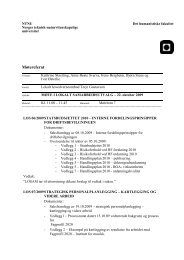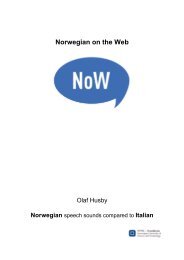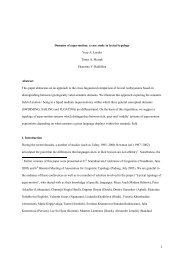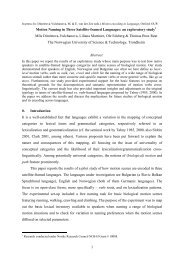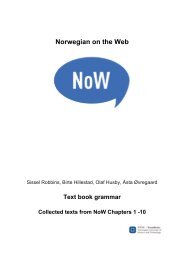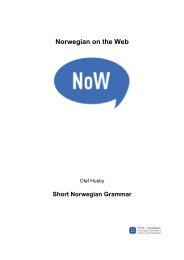The perception of articulation rate
The perception of articulation rate
The perception of articulation rate
You also want an ePaper? Increase the reach of your titles
YUMPU automatically turns print PDFs into web optimized ePapers that Google loves.
100<br />
75<br />
50<br />
25<br />
0<br />
FS<br />
100<br />
75<br />
50<br />
25<br />
0<br />
NCf<br />
100<br />
75<br />
50<br />
25<br />
0<br />
NCs<br />
100<br />
75<br />
50<br />
25<br />
0<br />
Figure 3: Percentages "stim1 faster" (black<br />
bars), "stim2 faster" (light gray bar) and "equal"<br />
(dark gray bars) averaged for each stimulus pair.<br />
Rows indicate the category <strong>of</strong> the first stimulus<br />
in a pair, while columns show the category <strong>of</strong> the<br />
second stimulus.<br />
4. GENERAL DISCUSSION<br />
SC<br />
Comparing prosodic structures differing in their surface<br />
complexity but with equal assumed underlying<br />
structures, Rietveld and Gussenhoven [5] found that<br />
resynthesised utterances with linked intonation contours<br />
are perceived as faster than utterances with physically<br />
equal speaking <strong>rate</strong> but unlinked contours. <strong>The</strong>y show<br />
this bias cannot be explained by the phonetic (number <strong>of</strong><br />
rising or falling movements) or phonological complexity<br />
(number <strong>of</strong> tone segments) <strong>of</strong> the utterance. <strong>The</strong>y<br />
conclude that the linked contour, implying absence <strong>of</strong> a<br />
tone domain boundary, causes a bias in the listener<br />
towards perceiving fast speech, beacuse linked<br />
intonation contours typically occur at faster speaking<br />
<strong>rate</strong>s.<br />
An interaction between underlying and surface<br />
realisation was also found on the segmental level in our<br />
experiment. Segment deletions as an extreme form <strong>of</strong><br />
reduction were shown to affect the <strong>perception</strong> <strong>of</strong><br />
speaking <strong>rate</strong>. A lower <strong>rate</strong> <strong>of</strong> surface events (realised<br />
phones) causes sloppy speech to be perceived as slower<br />
than clear speech when the intended <strong>rate</strong>s <strong>of</strong> the<br />
compared IP's are identical. On the other hand, the<br />
perceived speaking <strong>rate</strong> <strong>of</strong> sloppy IP's is not reduced so<br />
much that it becomes equal to that <strong>of</strong> clear IP's with the<br />
same realised <strong>rate</strong>. I.e. the <strong>perception</strong> <strong>of</strong> speaking <strong>rate</strong> in<br />
IP's is the product <strong>of</strong> the interaction between surface and<br />
underlying <strong>rate</strong>.<br />
Although the above effects are important in modelling<br />
the perceptual effects <strong>of</strong> natural speaking <strong>rate</strong>, the<br />
desirability <strong>of</strong> modelling natural speaking <strong>rate</strong> effects in<br />
speech technological applications using flexible-<strong>rate</strong><br />
synthesis remains an issue for further investigation [14].<br />
100<br />
75<br />
50<br />
25<br />
0<br />
NS<br />
FC<br />
FS<br />
NCf<br />
NCs<br />
NS<br />
REFERENCES<br />
[1] F. Goldman-Eisler, Psycholinguistics, London &<br />
New York: Academic Press, 1968.<br />
[2] C. Fougeron and S.-A. Jun, "Rate effect on French<br />
intonation: prosodic organization and phonetic<br />
realization," Journal <strong>of</strong> Phonetics, vol. 26, pp. 45–<br />
69, 1998.<br />
[3] K.J. Kohler, "Parameters <strong>of</strong> speech <strong>rate</strong> <strong>perception</strong><br />
in German words and sentences: duration, F0<br />
movement and F0 level," Language & Speech, vol.<br />
29, pp. 115–139, 1986.<br />
[4] J. Trouvain and M. Grice, "<strong>The</strong> effect <strong>of</strong> tempo on<br />
prosodic structure," Proc. 14th Int'l Conf. <strong>of</strong> the<br />
Phonetic Sciences (ICPhS), San Francisco, pp.<br />
1067-1070, 1999.<br />
[5] T. Rietveld and C. Gussenhoven, "Perceived speech<br />
<strong>rate</strong> and intonation," Journal <strong>of</strong> Phonetics, vol. 15,<br />
pp. 273–285, 1987.<br />
[6] J. Dankovičová, "Articulation <strong>rate</strong> variation within<br />
the intoantion phrase in Czech and English," Proc.<br />
14th Int'l Conf. <strong>of</strong> the Phonetic Sciences (ICPhS),<br />
San Francisco, pp. 269-272, 1999.<br />
[7] B. Lindblom, "Explaining phonetic variation: a<br />
sketch <strong>of</strong> the H&H theory," in Speech Production<br />
and Speech Modelling, W.J. Hardcastle and A.<br />
Marchal, Eds., pp. 403–439. Dordrecht/Boston/<br />
London: Kluwer Academic Publishers, 1990<br />
[8] A.M. Liberman and I.G. Mattingly, "<strong>The</strong> motor<br />
theory <strong>of</strong> speech <strong>perception</strong> revised," Cognition,<br />
vol. 21, pp. 1–36, 1985.<br />
[9] IPDS, <strong>The</strong> Kiel Corpus <strong>of</strong> Spontaneous Speech,<br />
vols. 1–3 (CD-ROM #2–4). Kiel: Insitut für<br />
Phonetik und digitale Sprachverarbeitung, 1995–<br />
1997.<br />
[10] J.Trouvain,J.Koreman,A.ErriquezandB.Braun,<br />
"Articulation <strong>rate</strong> measures and their relation to<br />
phone classification in spontaneous and read<br />
German," in: Proc. <strong>of</strong> the Isca ITR-Workshop on<br />
Adaptation Methods for Speech Recognition,<br />
Sophia-Antipolis, pp. 155-158, 2001.<br />
[11] H.R. Pfitzinger, "Local speech <strong>rate</strong> <strong>perception</strong> in<br />
German speech," Proc. 14th Int'l Conf. <strong>of</strong> the<br />
Phonetic Sciences (ICPhS), San Francisco, vol. 2,<br />
pp. 893–896, 1999<br />
[12] B. Lindblom, "Spectrographic study <strong>of</strong> vowel<br />
reduction," Journal <strong>of</strong> the Acoustical Society <strong>of</strong><br />
America, col. 35, nr. 11, pp. 1773–1781.<br />
[13] G. Altman, Experimenter. A Toolkit for Multi-Modal<br />
Psycholinguiistic Experimentation on the Apple<br />
Macintosh, Sussex: Laboratory <strong>of</strong> Eperimental<br />
Psychology, University <strong>of</strong> Sussex, 1992.<br />
[14] E. Janse, "Word <strong>perception</strong> in fast speech:<br />
artificially time-compressed vs. naturally<br />
produced fast speech," submitted to Speech<br />
Communication.


